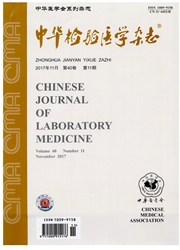

 中文摘要:
中文摘要:
目的制备Ⅱ型胶原C端肽中EKGPDP多肽片段(谷氨酸-赖氨酸-甘氨酸-脯氨酸-天冬氨酸-脯氨酸)的单克隆抗体(McAb),并进行抗体的纯化、鉴定及初步临床验证。方法采用戊二醛法制备EKGPDP-钥孔嘁血蓝素(keyholelimpethemocyanin,KLH)抗原载体复合物。腹腔及静脉攻击法免疫BALB/c小鼠8只。按常规方法将小鼠骨髓瘤细胞和免疫小鼠脾细胞融合。筛选阳性克隆株,以有限稀释法克隆3次。对杂交瘤细胞株的染色体、亲和力、类型和稳定性进行鉴定,取其中亲和力较高的6株制备腹腔积液,用盐析及蛋白G琼脂糖凝胶珠层析法纯化抗体。对McAb的纯度、特异性、交叉反应性及免疫活性进行鉴定。用免疫组化法对骨性关节炎膝关节软骨和椎间盘软骨样品进行分析。结果本研究获得13株能高效分泌特异性McAb的杂交瘤细胞株;经5个月传代35代和反复冻存复苏6次,培养上清稳定性良好。6株McAb腹腔积液效价分别为2.8×10^4(EKG7)、5.1×10^5(EKG14)、5.1×10^5(EKG16)、5.1×10^5(EKG18)、5.1×10^5(EKG25)、3.2×10^4(EKG28)。电泳结果证明,盐析法纯化腹腔积液得到的单克隆抗体回收量、活性、存放1周后活性分别为8.07mg、3.35(A450)、3.10(A450),蛋白G亲和层析法得到的单克隆抗体回收量、活性、存放1周后活性分别为0.32mg、1.83(A450)、0.66(A450),盐析法优于蛋白G亲和层析法(t=25.26,P〈0.01)。抗体的最佳应用浓度为(50~150)μg/L。临床初步鉴定发现,6株EKGPDP单克隆抗体在骨性关节炎及突出椎间盘软骨标本中出现了不同程度的阳性结果。结论本研究成功获得抗Ⅱ型胶原C端肽片段McAb,为Ⅱ型胶原降解产物的测定提供了研究工具。
 英文摘要:
英文摘要:
Objective To prepare, purify and validate specific monoclonal antibodies (McAb) against fragment in C-terminal telopeptides of collagen type Ⅱ (EKGPDP) for clinical diagnostics and related research of osteoarthritis ( OA). Methods 8 BALB/c mice were immunized with EKGPDP-KLH antigen complex. McAb against EKGPDP fragements were prepared by hybridoma technique. Immunoglobulin classes and subclasses were determined using an Immuno-TypeTM mouse McAb isotyping kit. Ascites were producted and McAb were purified by saturation ammonium sulfate (SAS) precipitation and protein G chromatography. Specificity and immunoactivity of antibodies were detected by indirect enzyme-linked immunosorbant assay (ELISA). Cartilage specimens were analyzed by immunohistochemical method. Results The hybridoma cells were obtained. 10 IgG and 3 IgM single colonies were picked out by limiting dilution and ELISA kit. The titers of McAb in ascites were from 2. 8 × 10^4 to 5.1 × 10^5. The McAb showed the characteristics of no cross reactions with KLH, BSA, cell culture supernatant, type Ⅰ , Ⅲ collagens and whole type Ⅱ collagen. The method of SAS could get better recovery, immunoactivity of the McAb than protein G chromatograply ( t = 25.26 ; P 〈 0.01 ). The competitive ELISA showed that there was a good interaction between antibodies and KEGPDP antigen. In SDS-PAGE analysis, the main bands were corresponding to 170kD, indicating good purity. There were both negative and positive results among clinical specimen of osteoarthritis and intervertebral disk hernia. Conclusion Hybridoma cell lines against EKGPDP are successfully obtained, providing a new tool to study degradation product of Collagen type Ⅱ.
 同期刊论文项目
同期刊论文项目
 同项目期刊论文
同项目期刊论文
 期刊信息
期刊信息
